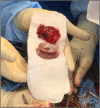Cardiac myxoma following transcatheter closure of an atrial septal defect
- PMID: 39165818
- PMCID: PMC11332617
- DOI: 10.1080/08998280.2024.2345557
Cardiac myxoma following transcatheter closure of an atrial septal defect
Abstract
To date, no significant association has been reported between atrial septal defects (ASD) and cardiac myxomas. This study reports a 56-year-old woman with cardiac myxoma following transcatheter closure of ASD. She presented with a 3-month history of recurrent dizziness, vertigo, palpitations, and generalized weakness after undergoing ASD occlusion a year earlier. Echocardiography and cardiac computed tomography scans identified a large, mobile mass (7.2 cm × 2.8 cm) in the left atrium, protruding through the mitral valve. The patient underwent median sternotomy and pericardiotomy, and the histopathological examination confirmed the diagnosis of atrial myxoma. The current case illustrates the challenges in determining whether an atrial mass is a benign myxoma or a dangerous thrombus. While there is no definitive link between the implantation of an ASD closure device and the formation of a myxoma, the emergence of this tumor is a potential occurrence.
Keywords: Amplatzer septal occluder; atrial myxoma; atrial septal defect; occlusion device; transcatheter closure.
Copyright © 2024 Baylor University Medical Center.
Conflict of interest statement
All in control of content for this article report no financial relationships with ineligible companies. The authors report no funding. The patient consented to the publication of this report.
Figures




References
Publication types
LinkOut - more resources
Full Text Sources
